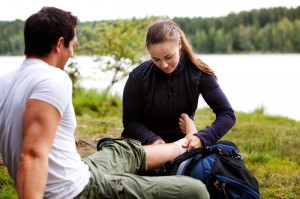Ankle Sprain Grade II Tear
Posted on November 18th, 2013 by Andries Lodder

Last week we looked at how to manage a grade I ankle sprain, this week we look at grade II, a more serious tear, that if mismanaged can leave the ankle and yourself vulnerable to greater injuries, long term.
The overall management plan is the same as for a grade I (Grade I ankle sprain)
Phase 1 – To control swelling, pain and spasms. This will again be the first couple of days.
PRICE will be the main focus during these first few days. It is important to go for an X-ray scan to rule out any chance of a fracture. An air splint is used during this period for support and compression. Crutches are used to avoid weight bearing for at least 3 to 4 days or until you can walk without a limp. Toe gripping and spreading exercises can be done starting the second day of injury as much as possible throughout the day, but again only if there is no pain.
Phase 2 – To decrease swelling, to restore full muscle contraction without pain and up to 50% pain free movement. This period can take up to 3 weeks.
It is very important that all treatments are immediately followed by exercise. Ice packs, ice massage or a cold whirlpool and massage above and below injury site can all be used to control hemorrhaging.
I am just going to name a couple of exercises that can be done, but always do these exercise with the supervision of a qualified Biokineticists to show you how to do all exercises correctly. Crutch walking, toe gripping and spreading, active PNF ankle patterns, , ankle circumduction, Achilles tendon stretches, toe raises, shifting body weight between injured and non-injured ankle and wobble board exercises should all be performed pain free.
Phase 3 – To restore full ROM and start performing power, speed and agility exercises. This phase will take approximately 3 to 5 weeks depending on each individuals own body response to all exercises.
Whirlpool and ultrasound can be used symptomatically. Achilles tendon stretches, resistance ankle exercises, wobble boards, systematic walk-jog routines, agility exercises and bouncing exercises must all be progressively performed pain free.
Only return to your sporting activity once ankle is pain free in a full ROM and strength retained during running, jumping, and sudden change in direction movements.
Tweet